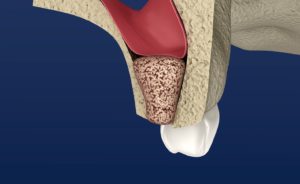 The first step to replacing your missing teeth with dental implants is a consultation with your dentist. Besides a visual examination, they rely on a CT scan of your mouth to determine if they are the right tooth replacement treatment for you. It’s not uncommon for the scans to show bone loss, which goes hand in hand with missing teeth. As a result, it’s not unusual for patients to require bone grafting before getting dental implants. Although it may add another step to your treatment plan, here’s how it will ensure the long-term success of your new smile.
The first step to replacing your missing teeth with dental implants is a consultation with your dentist. Besides a visual examination, they rely on a CT scan of your mouth to determine if they are the right tooth replacement treatment for you. It’s not uncommon for the scans to show bone loss, which goes hand in hand with missing teeth. As a result, it’s not unusual for patients to require bone grafting before getting dental implants. Although it may add another step to your treatment plan, here’s how it will ensure the long-term success of your new smile.
Why Does Bone Density Matter?
A dental implant is unlike any other treatment because it replaces both the root and crown. A titanium post is surgically placed into the jawbone to serve as a new root.
Your jaw must fuse to the post through a process called osseointegration for the procedure to be successful. If there’s insufficient bone, your dental implant won’t have the support it needs, ultimately leading to failure.
When is Bone Grafting Necessary?
Losing even a single tooth can have detrimental consequences for your oral health. You can lose 25% of your jawbone’s density within the first year of missing a tooth because it isn’t being stimulated by the root. Bone loss will continue as more time passes.
Bone grafting can strengthen areas of weakened bone caused by missing teeth; however, it can also be used to resolve other issues, including:
- Development defects
- Gum disease
- Facial injury or trauma
- After tooth extractions
After your jaw’s strength has been restored and adequate healing has occurred, you can move forward with your implant placement surgery.
How is Bone Grafting Performed?
Your dentist will use a local numbing agent or sedative to keep you comfortable as your gum tissue is opened to gain access to your jawbone. They’ll place a bone graft using tissue from another area of your body or a donor on the treatment area. Your gum tissue will be sutured closed, and you’ll need a few days to recover.
Your mouth will be healed on the surface in a couple of weeks, but it can take your jaw a few weeks to integrate with the graft. Your dentist will monitor the progression of your healing to determine the best time to schedule your placement surgery.
Give Your Dental Implants a Strong Foundation
Not everyone needs bone grafting before getting dental implants, but it isn’t uncommon. The procedure can be used along with a sinus lift and other procedures to create the healthy infrastructure your dental implants need to last for a lifetime. After just a few months, you’ll never have to worry about a gap in your smile again.
About Dr. Wael M. Kassem
Dr. Kassem earned his dental degree at Temple University and has continued his education in advanced specialties, like dental implants. He is a Fellow of the International Dental Implant Association and many other professional organizations. If you’re ready to treat your tooth loss, contact us through our website or call (856) 341-9472 to request your consultation.




